As a founding member of Sonic Youth, Kim Gordon was part of a group that challenged and ultimately changed the very way a generation heard rock music, all while morphing the perception of what the guitar’s role could be within the form. Breaking out of the vibrant experimentalist, anti-establishment New York no wave scene, Sonic Youth’s penchant for alternate tunings, prepared guitars, and signature use of noise as a textural and artistic device has since become de rigueur for many. In fact, the blasts of noise and feedback the immensely influential band incorporated into its musical vocabulary has since found its way into many disparate musical worlds, including that of contemporary hip hop.
While Sonic Youth is no more, Gordon has remained a prolific creative force, delving deeper into her physical art practice and making music as one half of the improvisational duo Body/Head, which finds the alt-rock icon singing and weaving droning guitar incantations alongside her musical partner, guitarist Bill Nace. Gordon has also recently made her first statement as a bona fide solo artist with the release of the downright danceable (and nonetheless dark) “Murdered Out.” The new single—an unexpected collaboration with producer Justin Raisen—is arguably the most approachable piece of music the bassist-turned-guitarist has ever released under any name.
Bill Nace is a dedicated and respected member of the improv guitar underground in which spontaneity and noise are cherished elements in crafting fleeting, raw musical moments. Within the context of Body/Head, Nace and Gordon share a special musical bond that relies upon an intuition of one another’s musical inclinations and a shared sense of dynamic counterpoint.
To truly understand what Body/Head does and is, it’s been said that one must experience it in the moment in which the pair crafts its tapestries of sound. No two performances are alike by design, and there are no songs to speak of in the traditional sense. Luckily for those unable to catch Body/Head in the flesh, the pair’s latest release, No Waves, captures an immense performance from the Big Ears Festival in Knoxville, Tennessee, in March 2014. The performance captures the expert feedback charmers deep in the thrall of their craft and at what they themselves have described as “peak chemistry.”
We spoke with the pair about the visceral energy that makes Body/Head work so well, their respective philosophies for improvisation, why neither of them take gear too seriously (Bill Nace’s main guitar was rescued from a pond), and how they stay passionate and inspired.
What brought about the release of No Waves?
Kim Gordon: It made sense for us to put out a live record because we are so improv-engineered in our approach, so each gig is different and this particular show sounded cohesive in a way that other shows of ours maybe aren’t. But the reality is someone sent us a tape of it and it sounded really good, so we went with it.
Were there any factors in particular that made the performance captured for No Waves so special and cohesive?
Gordon: Well, the theater was really beautiful for starters, and the Big Ears Festival has a really interesting program usually—anyone from Television to Faust has played it—so it’s kind of an interesting festival and the energy was great there to begin with. The sound was great, the setting was great, so all of the little things made for a really incredible show.
Bill Nace: I’ve been combing through a lot of our live stuff, because we’ve had a few very limited live releases come out recently, and a lot of them shared elements. There are some that I really liked as much as what became No Waves, but Kim really liked this show in particular because it had a lot of starts and stops, which made for a bunch of different pieces instead of one long whole piece, so we went with that concept. The pauses give it more of a song feel, which affects the way people listen to it a bit, as opposed to one of our sets, which is just one long song that isn’t as easily digested. Though I personally like to see where a single idea goes in that long-song format sometimes.
How does Body/Head start working on an idea?
Nace: I was asked recently if we talk about what we’re going to do beforehand much, and normally the answer is no, not at all. Once in a while, with Kim, we’ll figure out how we’ll start, but we want that to melt away pretty soon in the set either way. Just spending time with someone and talking about music and going through and editing your own music and, most importantly, understanding how the other person hears that, is just as important in teaching you what you should and shouldn’t bring into the situation. But it’s a pretty clean slate that we start with each time.
How do you define a good gig for Body/Head? Is there something you’re seeking during the performance?
Gordon: Not really. Sometimes it’s really dependent just on our amps sounding good—which isn’t always a given because we use backline a lot of the time—but if they’re working well, there’s a good chance it’ll be a good gig. Sometimes when you think it’s going to be really horrible, you can make it good and find interesting things in awkward moments. You really never know, which is sort of the point I suppose.
We always ask for Fender DeVilles, but often we end up with Fender Twins, which I just don’t get why people like them. They’re obviously good for certain kinds of guitar playing, but tend to have too much treble and not quite as full a range of sound as I’ve found I get from the DeVille. Not that I’m much of a gearhead, but that’s one thing I’ve found.
Nace: I hate using Twins too, even though Rowland S. Howard used one and made it sound incredible! I guess it’s a meditative state in a way, but I think every performance can be a little different. What can put you in that place one week doesn’t always work or do it the next week, so you have to be open to whatever’s happening and allow space to happen and follow it. What worked at the last two gigs doesn’t usually work at the next.
YouTube It
Like this performance at Boston’s Hassle Fest in 2014, Body/Head’s live show isn’t conventionally separated by songs or a prepared setlist—the concert is a continuous wall of sound.
Kim Gordon and Bill Nace perform as Body/Head at L.A.’s Echo nightclub in January 2015.
Photo by Debi Del Grande
Do you find inspiration in equipment like a lot of guitarists?
Gordon: Not so much, though I do really like the guitar I’m using right now, which is a newer Fender Jazzmaster that I got during our last Sonic Youth tour when we needed extra equipment because we were playing in South America and leap-frogging around. It’s just a great guitar that has a great tone, and it’s definitely inspiring to have something that sounds that good. I also like that it’s not special; that it’s not some vintage, rare Fender or something precious.
What is it about your two respective styles that you both find complementary?
Gordon: I tend to introduce a melody, or my version of a melody, and Bill is really great at finding something more textural or dissonant to contrast it. I like to also work in contrast against his ideas. Bill often comes up with really great loops that give me something great to work off of. It sounds like a typical answer, but I think we both just try to add things to each other’s ideas that aren’t typical of improvisational guitarists.
Nace: I feel like we have chemistry, so the answer becomes “how do you describe chemistry,” which is a little difficult. One of the major things is having the vocals there, which is a departure from a lot of the other things I play with, and I really love playing with her vocals there. Tonally, Kim’s vocals can shift a lot and be a lot of different things within one piece and it’s a cool challenge to try to support that and push it along. Kim’s voice is pretty iconic at this point and people just respond to hearing it. I think some of the sparse, more abstract stuff that we get into really benefits from her voice gluing things together and makes people hear it more as a song, which gives the guitars a lot of space to play around and maybe be more minimal.
In terms of the guitar stuff, I think there’s a really fluid movement between one of us framing the other, or one of us working a more supportive role and then taking the lead, but we also do a great job of sounding like one big instrument, and it flows back and forth between all of those things pretty easily. The openness that allows that to happen between us is something I really appreciate about playing with her.
Is it difficult for you to reconcile your duality as an experimental and improvisational guitarist and one that also plays conventional stuff?Gordon: No, because it’s all part of the same thing to me. They’re all good things that can be used and it’s just a vocabulary of sounds in my mind. Sometimes I really like to show that I know what I’m doing, and other times I try to avoid that and really try to not know what I’m doing and lose myself in that.
Can you tell me a bit about your approach to using effects within Body/Head?
Gordon: Well, I have a couple of lo-fi, funky loop pedals that I like to use a lot, but for the most part, I use the same stuff I’ve always used. A Dunlop Hendrix octave divider and a tremolo pedal, and what amounts to some pretty tame stuff.
There is so much out there and I never got that much into gear, but sometimes I get curious if I’m at a smaller guitar store and someone shows me something cool. That said, they all ultimately kind of seem the same to me—there’s just a gazillion distortion pedals and it’s easy to get lost in it. I guess I try to get into a mindset in which I’m not worried about what I’m playing on and just disappear into it and let things be what they’re going to be. That’s when the best stuff happens for me.
Kim Gordon’s Gear
Guitar and AmpFender Blacktop Jazzmaster
Fender Hot Rod DeVille 2x12
Effects
Dunlop Jimi Hendrix System Classic Fuzz
Dunlop TS-1 Stereo Tremolo
Electro-Harmonix Deluxe Memory Man
Boss GE-7 graphic EQ
Boss DD-3 Digital Delay
ZVEX Lo-Fi Loop Junky
Mu-Tron wah
Bill Nace’s Gear
Guitar and AmpMichael Kelly Patriot
Fender Hot Rod DeVille 2x12
Effects
Boss DS-1 Distortion
Ampeg Scrambler
Nace: I think people get too tripped up on pedals. People get bummed if they see too many, or they get obsessed with what kind of pedal it is to get the right sound. I’ve always been of the school of thought that you get what you can and you try to make it sound the closest to what you want to hear as possible. I don’t actually use anything that crazy—just a few different shades of distortion and I have a delay just barely on. I don’t like having all of the pedals on at once and layered. I know people that do that trick really well, but it’s not for me. I use, like, two pedals at once, max. I use a Boss DS-1 as a volume boost without any gain when I need a little more. I don’t get too into the gear side. The guitar I play with Body/Head, for example, my friend literally found it in a pond.
In a pond?
Nace: It was strapped with a belt to a Washburn bass and two other guitars bobbing up and down in a pond! My friend fished it out and gave it to me. When I started playing with Kim, I didn’t want to use any Fender guitars with her because the Jazzmaster and Jaguar are so closely associated with Sonic Youth, and I didn’t want to ride that wave. So I had this weird guitar and I started playing that with her. It’s a Michael Kelly Les Paul copy, and I never really liked Les Pauls before getting this guitar and now I love them! I’m really attached to it because I’ve used it so long now. When I first got it, I had to have the frets hammered back down and get it fixed up from its time in the pond. I had them run the serial number to make sure it didn’t belong to someone that might have wanted it back.
I know so many people who never get started because they’re always waiting on that last piece of gear. “Once I get a tube amp or once I get this…” I just think, “Get what you can and get on with it!” The amp I use for solo stuff outside of Body/Head is a Peavey Bandit a friend of mine found in the trash!
Legendary bassist Kim Gordon has turned to 6-strings, and currently plays a Fender Blacktop Jazzmaster in her band Body/Head. “It’s just a great guitar that has a great tone,” she says. “I also like that it’s not special; that it’s not some vintage, rare Fender or something precious.” Photo by Debi Del Grande
Kim, as someone who began her career as a bass player, do you have a preference between instruments at this point? Was the switch to guitar for any specific reason?
Gordon: I mostly just play guitar now because it’s so much better for the kind of music I make. I also have really bad tendinitis from my years playing bass, which really was a much harder instrument for me.
I’ve always loved that white B.C. Rich Mockingbird bass you used back in the early days of Sonic Youth.
Gordon: That was a joke bass, actually, but it was also a very light instrument and I loved it. By the end, I was playing lighter and lighter basses, like the SG bass I wound up using. That Gibson Thunderbird I used was a really hard bass to play. But the Mockingbird was totally something I looked at like a fashion accessory, and it was J Mascis’ fault I wound up with that one. He said once “you should get a white bass” and we were at a music store together and he pointed at it and said “you should get that one” and I grabbed it and that was that!
Bill, are you an educated player?
Nace: I’m self-taught and I started with bass like Kim, actually. I had some lessons on bass from Chris DiPinto of DiPinto guitars in Philly early on, but I didn’t learn that much technically because we’d always just end up talking about music during the lessons. It was a big deal for me because he was this older guy that was into all of this cool stuff and he really spoke to me like a peer, and I was 14 years old. So that was a good experience to have at that point, but I’m a self-taught guitarist.
Kim, what’s your take on noise and darker elements being accepted in the mainstream these days?
Gordon: It’s interesting that it’s there now, though when it’s used sometimes, it still sounds really clinical to me. When Sonic Youth first started, noise was a derogatory term. It wasn’t something you’d necessarily want to include in your band description, so it’s interesting to see how things have changed and it’s become accepted.
Nace’s Michael Kelly Patriot was given to him by a friend who found the guitar floating in a pond. “I never really liked Les Pauls before getting this guitar, and now I love them,” says Nace. Photo by Debi Del Grande
Is there a key to staying inspired and passionate about what you do, this far into your career?
Gordon: I think it helps if you don’t try to make money and treat it as if there’s no money to be had doing something creative. It’s tough to pinpoint where it comes from though, but I guess the whole living by the “you’re only as good as your last show” thing, as many times as it’s been said, really does keep you going.
Bill, I’ve read that you pull a lot of influence from film and cinematic music. Are there any composers in particular that inform your playing in Body/Head?
Nace: Toru Takemitsu is one of my favorites and I absolutely love him. He [scored] a film called Women in the Dunes that was really great. He always does this thing with contrast where if something sweet is happening on screen, he does something a little sour. Just a brilliant use of counterpoint.
Do you take influence from any guitarists in particular?
Nace: Japanese guitarist Masayuki Takayanagi was absolutely huge for me. Totally opened that world up to me. I also really like Lindsey Buckingham. His playing is just gorgeous and I just love what he does. He always does exactly what the song needs and it manages to always be both simple and complex. The guitarist of Jesus Lizard, Duane Denison, was really influential too; he really understands economy and he’ll play two notes if that’s what the song needs, but he gets the dub idea that it’s all about placement and where you put things. Ron Asheton from the Stooges played in the same way, focusing more on where things go rather than how flashy the part itself is, and it takes the whole thing to another level for me. I love that.
No Waves is a live recording taken from Body/Head’s performance at the Big Ears Festival in Knoxville, Tennessee, on March 24, 2014. Instead of traditional songs, the album is a snapshot of moments from the set.
Kim Gordon: Blackouts and Spotlights
While Kim Gordon has been a part of countless projects over the years as both a musician and artist, “Murdered Out,” a one-off single the icon created with producer Justin Raisen, is the first time she’s released music under her own name. It’s an unexpected pairing, and the single is well removed from anything Gordon’s done in the past. The track is a hooky, danceable jammer built around a heavy, languid drum loop (performed by Warpaint’s Stella Mozgawa) and a haunting loop of Gordon’s vocals. While the song is undoubtedly the most approachable thing Gordon has worked on, it revels in trashy feedback and distortion and remains distinctly hers. We spoke with Gordon about how the track came to be, her intentions for the song, and her future as a solo artist.I’ve read that living in Los Angeles had a really heavy influence on the new single. Could you elaborate a little on that?
Well, I inadvertently met Justin [Raisen] in L.A. and it wouldn’t have occurred to me to work the way we did to make that song without his involvement, so that’s one thing. But driving around L.A. and seeing these murdered-out cars—totally blacked out with matte spray paint—was always really interesting to me. Also, the many different ways in which communities form is interesting to me, and one big community in L.A. is the car world and low-rider car community. There’s a lot of aspects of customization and personalization that goes on in L.A., between that car culture and even people’s houses there, so I was interested in that. Also the way cars can be seen as a status symbol, and how taking something like that and murdering it out can make it something of an anti-status symbol, but another status symbol at the same time within that community: The idea that I’m blacking myself out of this culture, often in a DIY way.
Did you enjoy working in that way, with loops and a bed already in place beforehand?
Yeah, I liked it! It was fun not knowing how it was going to come out. It was a little like improvising, in a way, though it was really like collaging in essence. Justin had my vocals and he made the rhythm track and laid down the bass and developed all of those things around my vocals, so I think it worked out really well because of that process. I laid down more guitars after all of that was done.
Was there a specific approach to laying down the guitar parts?
I just wanted to make it very textural and use it as another layer and add another element of trashiness to it.
I’ve read this was not necessarily intended to be your first statement specifically as a solo artist. However, now that the track is out, do you intend to pursue a solo career?
Yeah, I think we might do some more stuff together, Justin and I. I don’t have any burning desire to be a solo artist, really, because I’ve always felt like my art practice was always more along those lines. But I’m intrigued by the way Justin and I work and I’d like to do more.



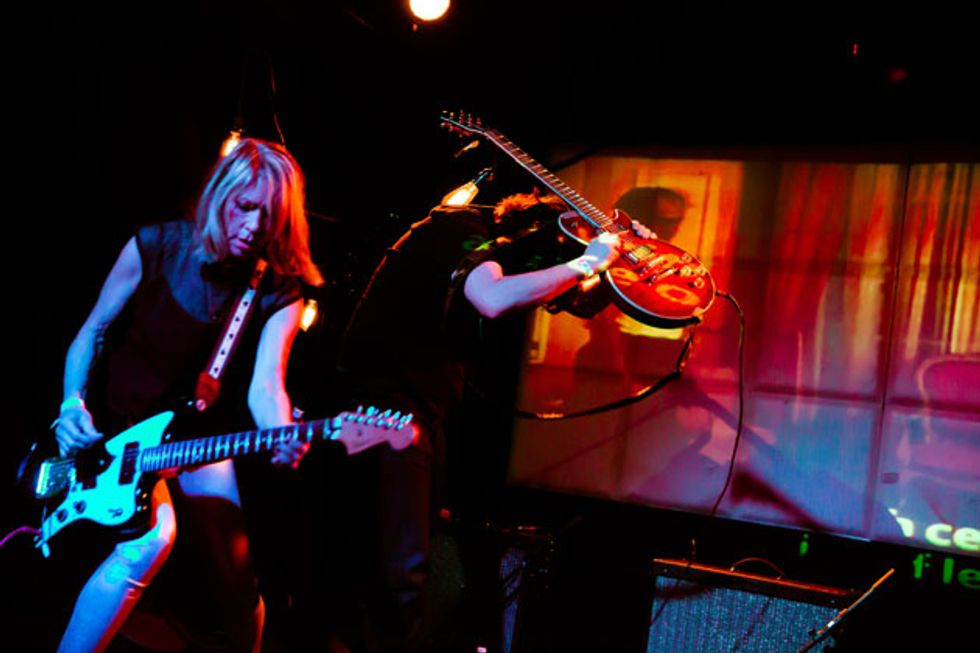

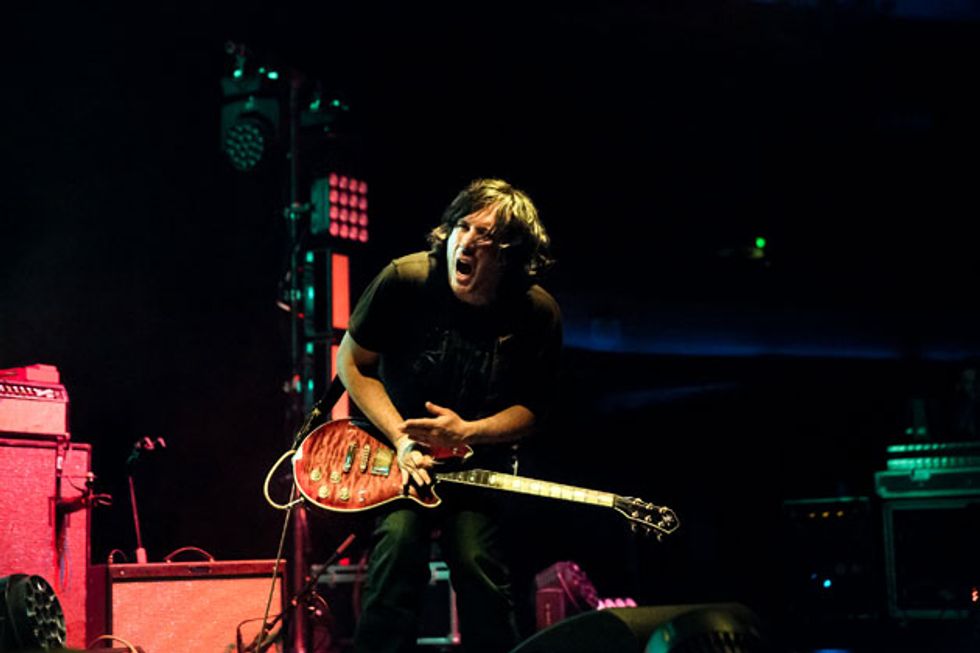
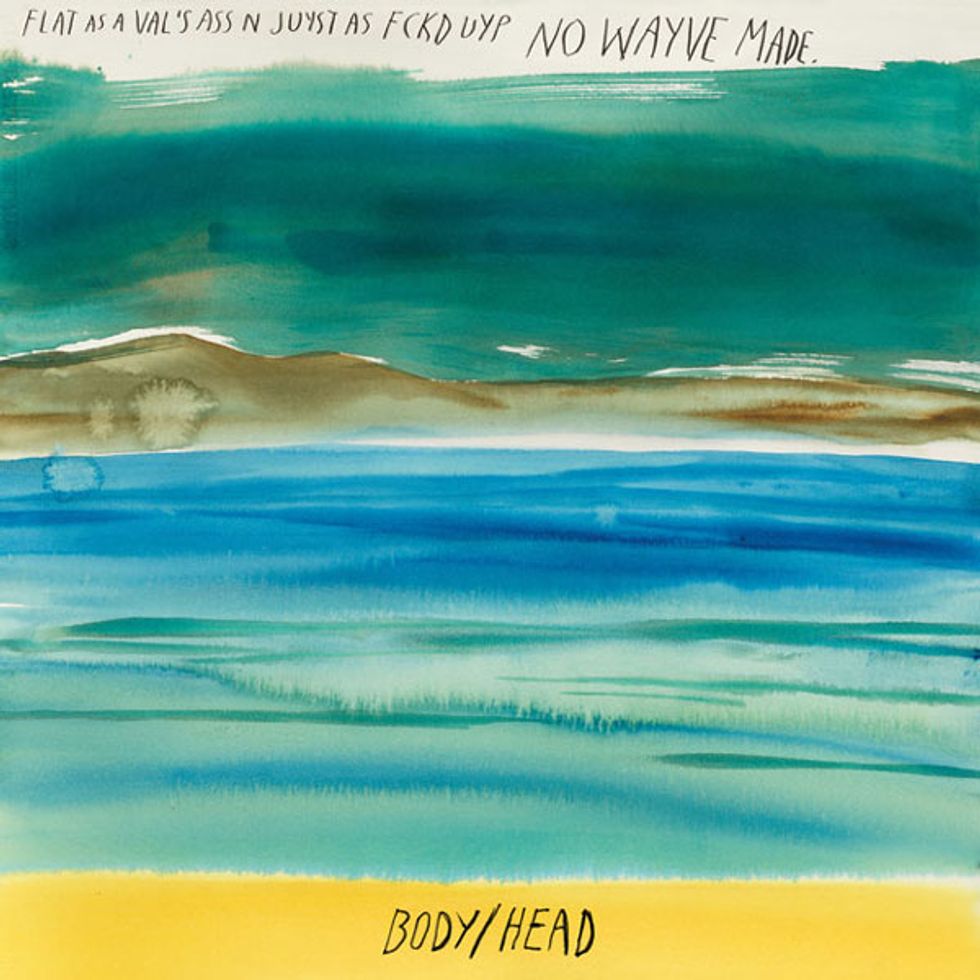





![Rig Rundown: Russian Circles’ Mike Sullivan [2025]](https://www.premierguitar.com/media-library/youtube.jpg?id=62303631&width=1245&height=700&quality=70&coordinates=0%2C0%2C0%2C0)

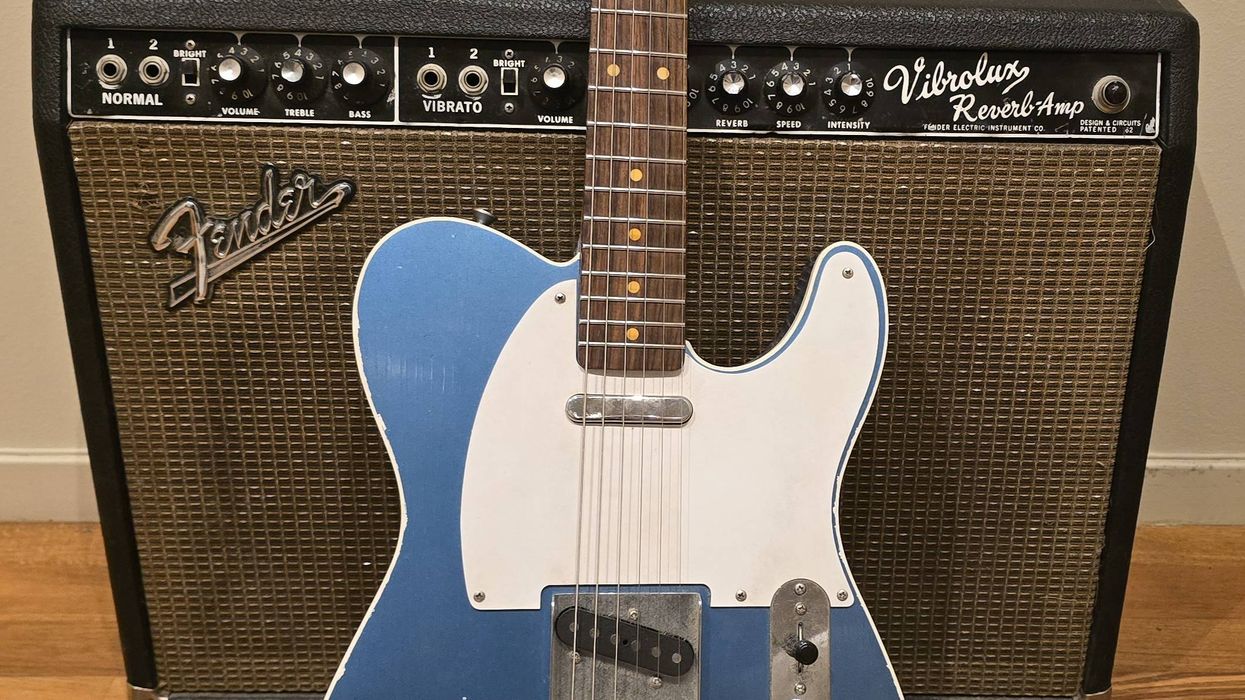
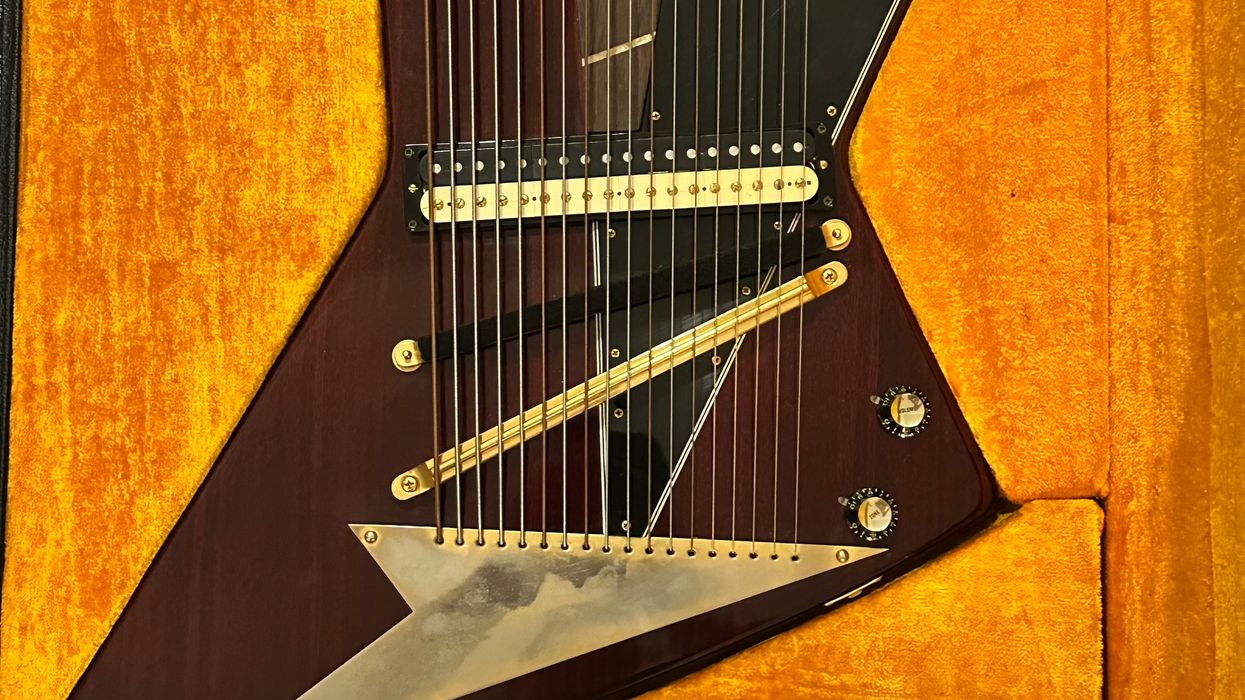
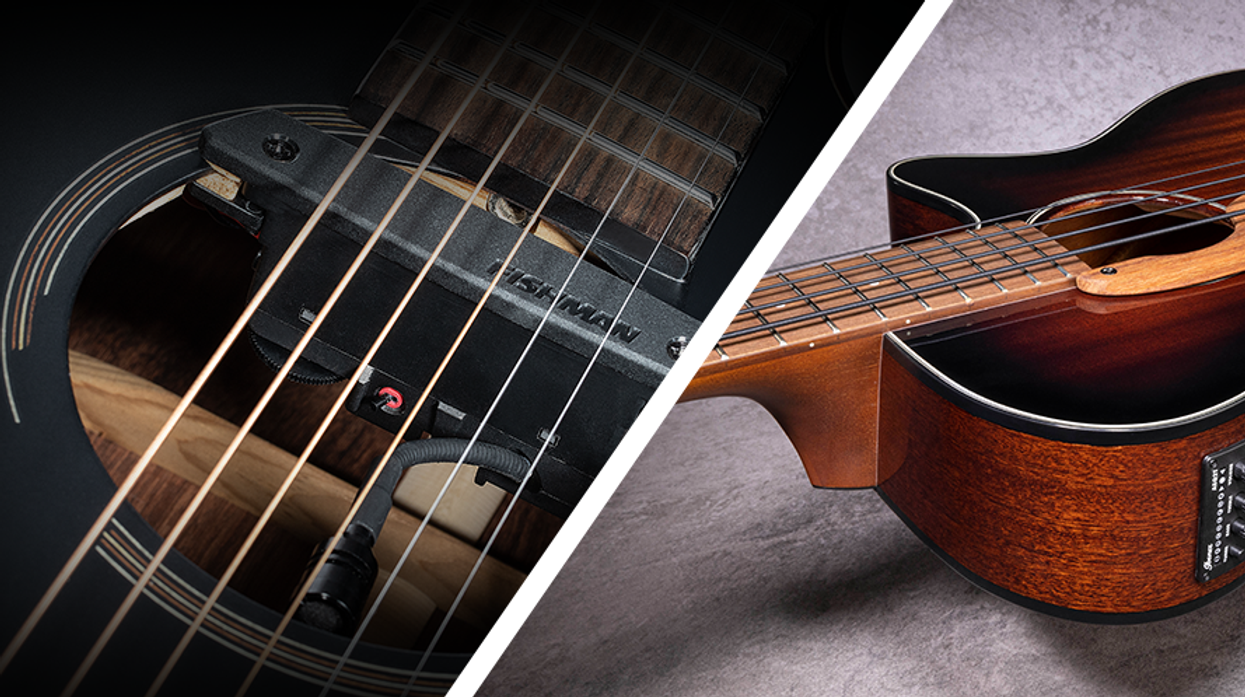
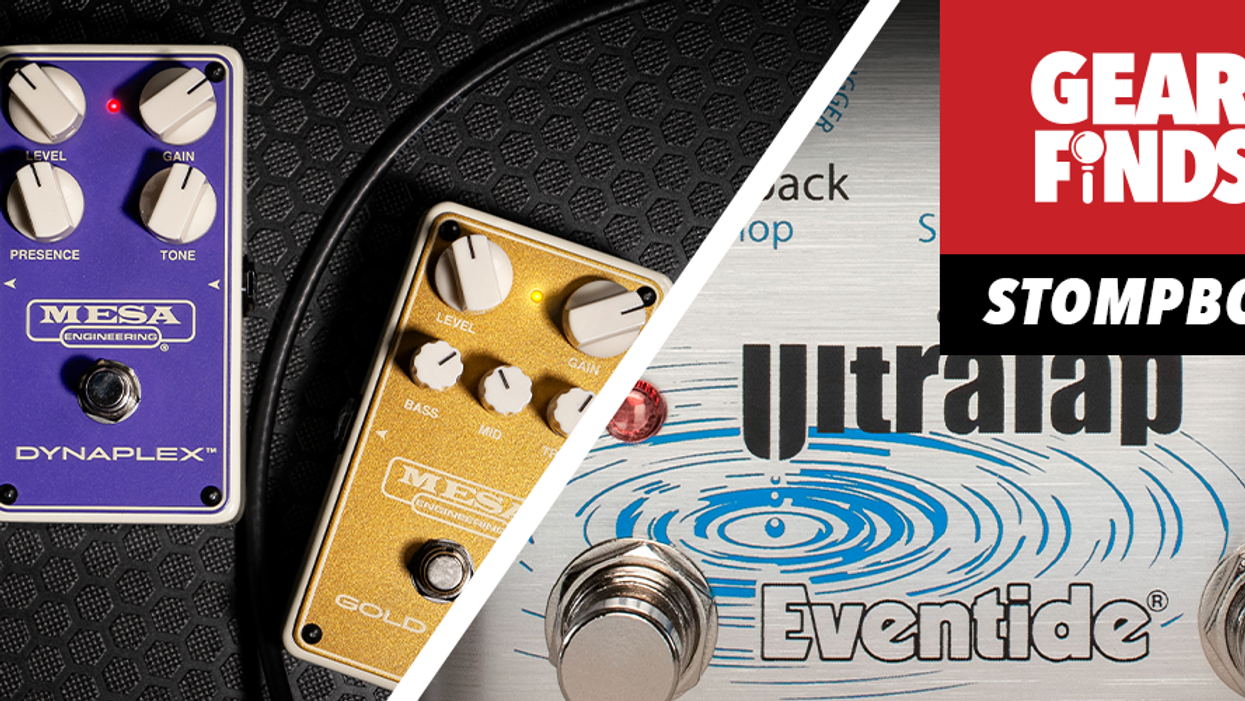










![Rig Rundown: AFI [2025]](https://www.premierguitar.com/media-library/youtube.jpg?id=62064741&width=1245&height=700&quality=70&coordinates=0%2C0%2C0%2C0)




















 Zach loves his Sovtek Mig 60 head, which he plays through a cab he built himself at a pipe-organ shop in Denver. Every glue joint is lined with thin leather for maximum air tightness, and it’s stocked with Celestion G12M Greenback speakers.
Zach loves his Sovtek Mig 60 head, which he plays through a cab he built himself at a pipe-organ shop in Denver. Every glue joint is lined with thin leather for maximum air tightness, and it’s stocked with Celestion G12M Greenback speakers.











